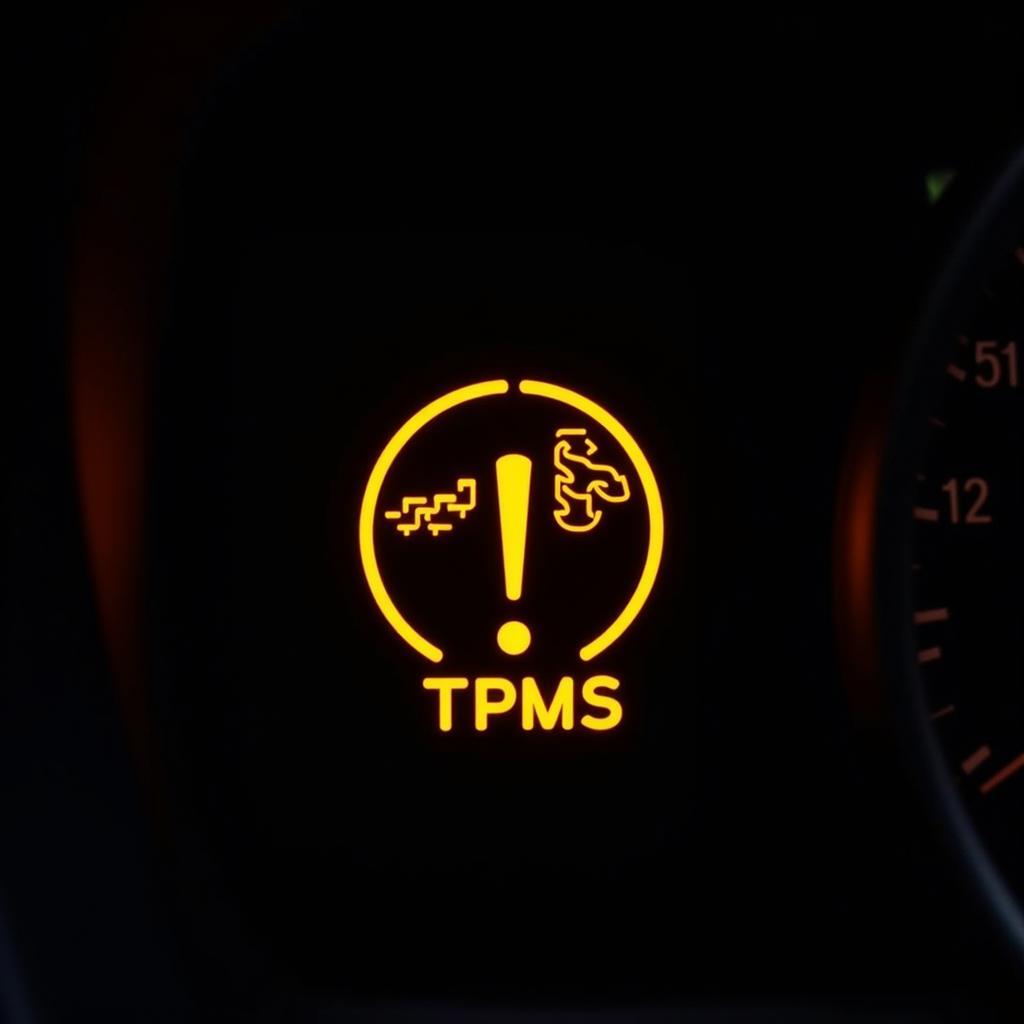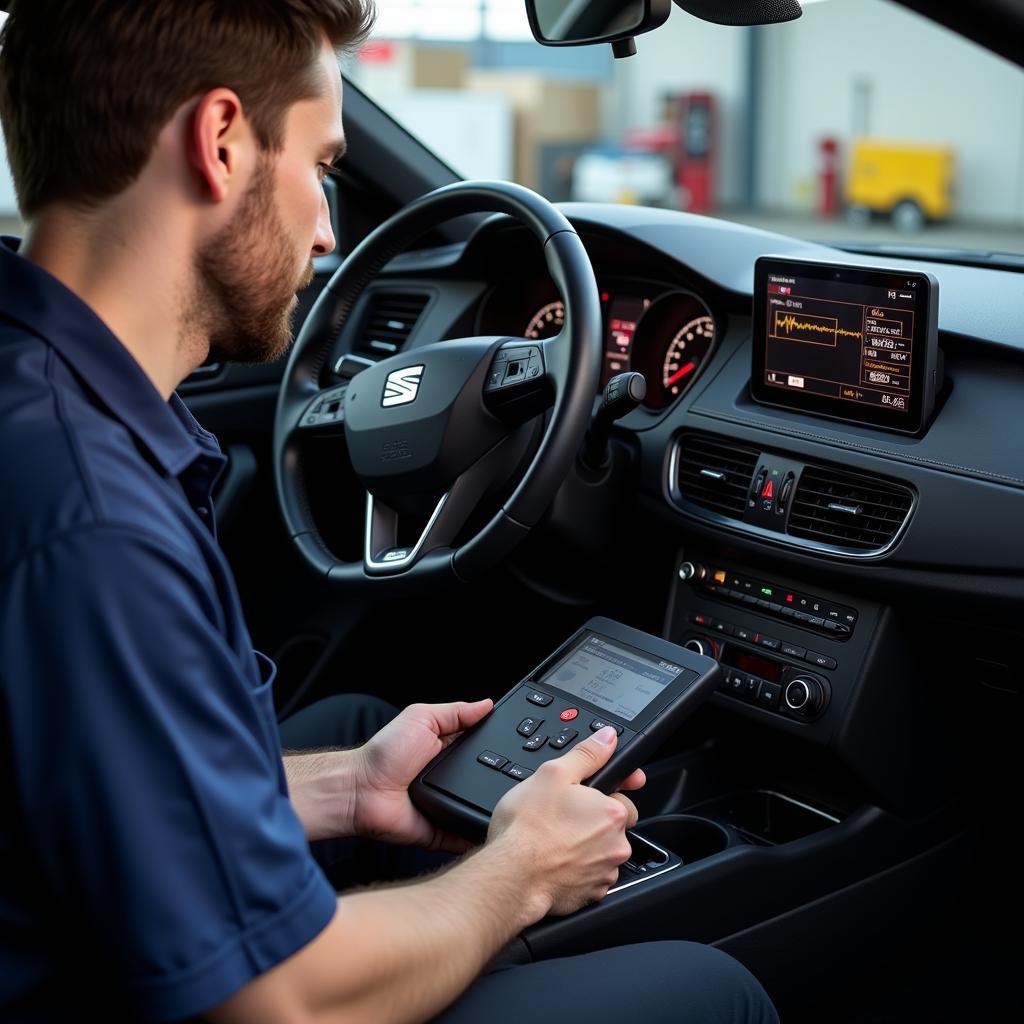The dreaded tyre pressure warning light on your Seat Leon dashboard can be a cause for concern. It signals a potential issue with one or more of your tyres, requiring immediate attention to ensure your safety and the car’s performance. This comprehensive guide will walk you through the common causes of this warning light, how to diagnose the problem, and the steps you can take to resolve it.
Understanding Your Seat Leon’s Tyre Pressure Monitoring System (TPMS)
Your Seat Leon is equipped with a Tyre Pressure Monitoring System (TPMS), a crucial safety feature that continuously monitors the air pressure in your tyres. There are two main types of TPMS:
- Direct TPMS: This system utilizes sensors within each wheel, directly measuring the tyre pressure and transmitting this information to your car’s computer.
- Indirect TPMS: Instead of direct pressure sensors, this system relies on the wheel speed sensors (part of the Anti-lock Braking System – ABS). It detects variations in wheel rotation speeds, which can indicate underinflation.
When the TPMS detects a pressure discrepancy, typically 15% or more below the recommended pressure, it triggers the warning light on your dashboard.
 Seat Leon TPMS Warning Light
Seat Leon TPMS Warning Light
Common Causes of a Seat Leon Tyre Pressure Warning Light
While a puncture is the most obvious culprit, several other factors can activate your Seat Leon’s TPMS warning light:
- Underinflated Tyres: Even without a puncture, tyres naturally lose air over time. Temperature fluctuations can also impact tyre pressure.
- Faulty Tyre Pressure Sensors: If your Seat Leon has a direct TPMS, a malfunctioning sensor can send inaccurate readings, triggering the warning light.
- Sensor Battery Issues: Tyre pressure sensors are battery-powered, and like any battery, they have a limited lifespan. A depleted battery can disrupt the sensor’s function.
- Recent Tyre Change or Rotation: If you’ve recently had your tyres changed or rotated, there’s a chance the sensors weren’t properly reset or that the system needs recalibration.
Diagnosing the Problem
Before rushing to the garage, you can perform some basic checks:
- Visually Inspect Your Tyres: Look for any obvious signs of damage like punctures, cuts, bulges, or objects embedded in the tread.
- Check Tyre Pressure: Use a reliable tyre pressure gauge to check each tyre’s pressure. Refer to the sticker on your driver’s side door jamb or your owner’s manual for the recommended pressure.
- Examine the Warning Light: Observe the warning light’s behavior. A flashing light often indicates a TPMS system malfunction, while a solid light usually points to a pressure issue.
 Checking Tyre Pressure with a Gauge
Checking Tyre Pressure with a Gauge
Resolving the Tyre Pressure Warning Light Issue
The solution to your Seat Leon’s tyre pressure warning light depends on the root cause:
- Underinflation: Inflate your tyres to the recommended pressure using a reliable air compressor. Remember to check the pressure when the tyres are cold for an accurate reading.
- Puncture: A slow puncture might require a tyre sealant as a temporary measure, but a professional repair or replacement is often necessary.
- Faulty Sensor: A qualified technician with a diagnostic tool can identify and replace a malfunctioning tyre pressure sensor.
- Sensor Battery: Unfortunately, most tyre pressure sensors aren’t serviceable, meaning a replacement is usually required when the battery dies.
- System Reset: If the issue arose after a tyre change or rotation, consult your owner’s manual for the TPMS reset procedure. This typically involves driving at a certain speed for a set duration to recalibrate the system.
“Regularly checking your tyre pressure is essential for maintaining optimal fuel efficiency, tyre longevity, and most importantly, your safety on the road,” says John Miller, a seasoned automotive engineer specializing in vehicle safety systems. “Don’t ignore the TPMS warning light; it’s a crucial safety net designed to alert you to potential issues.”
When to Seek Professional Help
While some TPMS issues can be resolved with basic checks and adjustments, it’s best to consult a qualified mechanic if:
- You’re uncomfortable troubleshooting the issue yourself.
- The warning light persists despite inflating your tyres to the correct pressure.
- You suspect a faulty sensor or TPMS system malfunction.
 Mechanic Diagnosing TPMS Issue
Mechanic Diagnosing TPMS Issue
Conclusion
The tyre pressure warning light on your Seat Leon is a vital safety feature you should never ignore. Understanding its causes and knowing how to address them can save you from potential headaches and ensure a safe and enjoyable driving experience. Remember, regular tyre pressure checks and prompt attention to the warning light will keep you rolling smoothly and safely.
Frequently Asked Questions
1. How often should I check my Seat Leon’s tyre pressure?
It’s best practice to check your tyre pressure at least once a month and before embarking on long journeys.
2. Can I drive with the TPMS warning light on?
While you can technically drive a short distance, it’s highly discouraged. Driving with underinflated tyres compromises handling, fuel efficiency, and safety.
3. How long do tyre pressure sensor batteries last?
Sensor batteries typically last between 5 to 10 years, depending on usage and environmental factors.
4. Can I replace a Seat Leon tyre pressure sensor myself?
While possible for those with mechanical expertise, it’s generally recommended to have a qualified technician handle sensor replacements to ensure proper installation and system recalibration.
5. What does a flashing TPMS warning light indicate?
A flashing light usually suggests a malfunction within the TPMS system itself, requiring a professional diagnosis.
